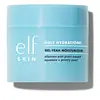What's inside
What's inside
 Key Ingredients
Key Ingredients

 Benefits
Benefits

 Concerns
Concerns

 Ingredients Side-by-side
Ingredients Side-by-side

Water
Skin ConditioningButylene Glycol
HumectantTrehalose
HumectantBis-PEG-18 Methyl Ether Dimethyl Silane
EmollientDiglycerin
HumectantSqualane
EmollientOpunta Dillenii Extract
Allantoin
Skin ConditioningSodium Hyaluronate
HumectantTocopherol
AntioxidantDipropylene Glycol
HumectantAcrylates/C10-30 Alkyl Acrylate Crosspolymer
Emulsion StabilisingArginine
MaskingHydroxyacetophenone
Antioxidant1,2-Hexanediol
Skin ConditioningDimethicone
EmollientDisodium EDTA
Parfum
MaskingGeraniol
PerfumingLinalool
PerfumingWater, Butylene Glycol, Trehalose, Bis-PEG-18 Methyl Ether Dimethyl Silane, Diglycerin, Squalane, Opunta Dillenii Extract, Allantoin, Sodium Hyaluronate, Tocopherol, Dipropylene Glycol, Acrylates/C10-30 Alkyl Acrylate Crosspolymer, Arginine, Hydroxyacetophenone, 1,2-Hexanediol, Dimethicone, Disodium EDTA, Parfum, Geraniol, Linalool
Water
Skin ConditioningGlycerin
HumectantIsopropyl Palmitate
EmollientCetyl Alcohol
EmollientCetearyl Olivate
Sorbitan Olivate
EmulsifyingAlanine
MaskingMaltose
MaskingGlycine
BufferingAllantoin
Skin ConditioningLidocaine Hcl
Arginine
MaskingSerine
MaskingProline
Skin ConditioningThreonine
Ethylhexylglycerin
Skin ConditioningPentylene Glycol
Skin ConditioningCeramide NP
Skin ConditioningTropolone
Skin ConditioningSodium Hyaluronate
Humectant1,2-Hexanediol
Skin ConditioningCaprylyl Glycol
EmollientTrehalose
HumectantBetaine
HumectantUrea
BufferingFructose
HumectantGlucose
HumectantPCA
HumectantSodium PCA
HumectantGlutamic Acid
HumectantSodium Lactate
BufferingPalmitic Acid
EmollientStearic Acid
CleansingDimethicone
EmollientSodium Chloride
MaskingPolyacrylate Crosspolymer-6
Emulsion StabilisingC10-30 Cholesterol/Lanosterol Esters
EmulsifyingT-Butyl Alcohol
PerfumingSodium Hydroxide
BufferingCitric Acid
BufferingTocopherol
AntioxidantWater, Glycerin, Isopropyl Palmitate, Cetyl Alcohol, Cetearyl Olivate, Sorbitan Olivate, Alanine, Maltose, Glycine, Allantoin, Lidocaine Hcl, Arginine, Serine, Proline, Threonine, Ethylhexylglycerin, Pentylene Glycol, Ceramide NP, Tropolone, Sodium Hyaluronate, 1,2-Hexanediol, Caprylyl Glycol, Trehalose, Betaine, Urea, Fructose, Glucose, PCA, Sodium PCA, Glutamic Acid, Sodium Lactate, Palmitic Acid, Stearic Acid, Dimethicone, Sodium Chloride, Polyacrylate Crosspolymer-6, C10-30 Cholesterol/Lanosterol Esters, T-Butyl Alcohol, Sodium Hydroxide, Citric Acid, Tocopherol
 Reviews
Reviews

Ingredients Explained
These ingredients are found in both products.
Ingredients higher up in an ingredient list are typically present in a larger amount.
1,2-Hexanediol is a synthetic liquid and another multi-functional powerhouse.
It is a:
- Humectant, drawing moisture into the skin
- Emollient, helping to soften skin
- Solvent, dispersing and stabilizing formulas
- Preservative booster, enhancing the antimicrobial activity of other preservatives
Allantoin is a soothing ingredient known for its protective and moisturizingg properties. Because of this, it is often added to products with strong active ingredients.
Studies show higher concentrations of this ingredient can promote wound healing.
Though it can be derived from the comfrey plant, allantoin is produced synthetically for cosmetic products to ensure purity.
Learn more about AllantoinArginine is an amino acid that is important for human development. Your body uses is it to produce hair keratin and skin collagen.
As a cosmetic ingredient, Arginine has antioxidant properties and can also help repair damaged skin. This ingredient is derived either synthetically or from animals.
Arginine isn't fungal acne safe when used in the presence of other lipids (fats, fatty acids, oils, esters, etc). Oils and fats occur naturally within the skin, so take caution when using Arginine if you're prone to fungal acne.
Learn more about ArginineDimethicone is a type of synthetic silicone created from natural materials such as quartz.
What it does:
Dimethicone comes in different viscosities:
Depending on the viscosity, dimethicone has different properties.
Ingredients lists don't always show which type is used, so we recommend reaching out to the brand if you have questions about the viscosity.
This ingredient is unlikely to cause irritation because it does not get absorbed into skin. However, people with silicone allergies should be careful about using this ingredient.
Note: Dimethicone may contribute to pilling. This is because it is not oil or water soluble, so pilling may occur when layered with products. When mixed with heavy oils in a formula, the outcome is also quite greasy.
Learn more about DimethiconeSodium Hyaluronate is hyaluronic acid's salt form. It is commonly derived from the sodium salt of hyaluronic acid.
Like hyaluronic acid, it is great at holding water and acts as a humectant. This makes it a great skin hydrating ingredient.
Sodium Hyaluronate is naturally occurring in our bodies and is mostly found in eye fluid and joints.
These are some other common types of Hyaluronic Acid:
Learn more about Sodium HyaluronateTocopherol (also known as Vitamin E) is a common antioxidant used to help protect the skin from free-radicals and strengthen the skin barrier. It's also fat soluble - this means our skin is great at absorbing it.
Vitamin E also helps keep your natural skin lipids healthy. Your lipid skin barrier naturally consists of lipids, ceramides, and fatty acids. Vitamin E offers extra protection for your skin’s lipid barrier, keeping your skin healthy and nourished.
Another benefit is a bit of UV protection. Vitamin E helps reduce the damage caused by UVB rays. (It should not replace your sunscreen). Combining it with Vitamin C can decrease sunburned cells and hyperpigmentation after UV exposure.
You might have noticed Vitamin E + C often paired together. This is because it is great at stabilizing Vitamin C. Using the two together helps increase the effectiveness of both ingredients.
There are often claims that Vitamin E can reduce/prevent scarring, but these claims haven't been confirmed by scientific research.
Learn more about TocopherolTrehalose is a disaccharide made of two glucose molecules (glucose is sugar!). Trehalose is used to help moisturize skin. It also has antioxidant properties.
As a humectant, trehalose helps draw moisture from the air to your skin. This helps keep your skin hydrated.
Due to its antioxidant properties, trehalose may help with signs of aging. Antioxidants help fight free-radical molecules, unstable molecules that may damage your skin.
In medicine, trehalose and hyaluronic acid are used to help treat dry eyes.
Some animals, plants, and bacteria create trehalose as a source of energy to survive freeze or lack of water.
Learn more about TrehaloseWater. It's the most common cosmetic ingredient of all. You'll usually see it at the top of ingredient lists, meaning that it makes up the largest part of the product.
So why is it so popular? Water most often acts as a solvent - this means that it helps dissolve other ingredients into the formulation.
You'll also recognize water as that liquid we all need to stay alive. If you see this, drink a glass of water. Stay hydrated!
Learn more about Water